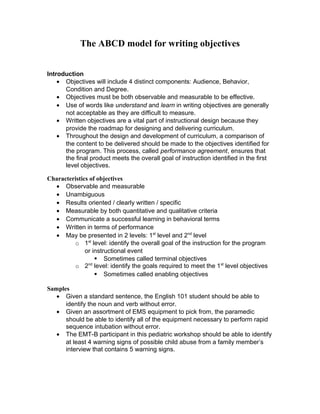
Abcd model for writing objectives
- 1. The ABCD model for writing objectives Introduction • Objectives will include 4 distinct components: Audience, Behavior, Condition and Degree. • Objectives must be both observable and measurable to be effective. • Use of words like understand and learn in writing objectives are generally not acceptable as they are difficult to measure. • Written objectives are a vital part of instructional design because they provide the roadmap for designing and delivering curriculum. • Throughout the design and development of curriculum, a comparison of the content to be delivered should be made to the objectives identified for the program. This process, called performance agreement, ensures that the final product meets the overall goal of instruction identified in the first level objectives. Characteristics of objectives • Observable and measurable • Unambiguous • Results oriented / clearly written / specific • Measurable by both quantitative and qualitative criteria • Communicate a successful learning in behavioral terms • Written in terms of performance • May be presented in 2 levels: 1st level and 2nd level o 1st level: identify the overall goal of the instruction for the program or instructional event Sometimes called terminal objectives o 2nd level: identify the goals required to meet the 1st level objectives Sometimes called enabling objectives Samples • Given a standard sentence, the English 101 student should be able to identify the noun and verb without error. • Given an assortment of EMS equipment to pick from, the paramedic should be able to identify all of the equipment necessary to perform rapid sequence intubation without error. • The EMT-B participant in this pediatric workshop should be able to identify at least 4 warning signs of possible child abuse from a family member’s interview that contains 5 warning signs.
- 2. 4 Parts of an ABCD Objective • Audience • Behavior • Condition • Degree o The objective does not have to be written in this order (ABCD), but it should contain all of these elements Audience • Describe the intended learner or end user of the instruction • Often the audience is identified only in the 1st level of objective because of redundancy • Example: The paramedic refresher participant… • Example: The EMT-B student… • Example: The prehospital care provider attending this seminar… Behavior • Describes learner capability • Must be observable and measurable (you will define the measurement elsewhere in the goal) • If it is a skill, it should be a real world skill • The “behavior” can include demonstration of knowledge or skills in any of the domains of learning: cognitive, psychomotor, affective, or interpersonal • Example: … should be able to write a report… • Example: …should be able to describe the steps… o Cognitive domain Emphasizes remembering or reproducing something which has presumably been learned Deal with what a learner should know, understand, comprehend, solve, spell, critique, etc. o Psychomotor domain Emphasizes some muscular motor skill, some manipulation of material and objects, or some act that requires a neuromuscular coordination Concerned with how a learner moves or controls his/her body o Affective domain Composed of two different types of behaviors: reflexive (attitudes) and voluntary reactions and actions (values) Stages: perception, decision, action and evaluation o Interpersonal domain Emphasizes learner skills (not attitude or knowledge) associated with interpersonal exchanges
- 3. How a learner interacts with others in a variety of situations Condition • Equipment or tools that may (or may not) be utilized in completion of the behavior • Environmental conditions may also be included • Example: …given an oxygen wrench, regulator and D tank with oxygen… • Example: …given the complete works of William Shakespeare… • Example: …given the following environment: 10PM, snowing, temperature 0 degrees C… Degree • States the standard for acceptable performance (time, accuracy, proportion, quality, etc) • Example: … without error. • Example: … 9 out of 10 times. • Example: …within 60 seconds. Review of ABCD Objectives • Who is to exhibit the performance? • What observable performance is the learner to exhibit? • What conditions are provided for the learner at the time of evaluation? • What constitutes a minimum acceptable response? Performance Agreement • Reiterative process where content is compared to objectives to determine if the content being delivered actually enables the student to meet the objectives o Be “reiterative” we mean that throughout the development of the course you should be reviewing to see if performance agreement is present. It is much easier to make minor adjustments as you go along than it is to make major changes in the end. • If you cannot clearly see that the content being delivered meets the objectives then you must decide the following: o Rewrite the objectives to meet the content o Modify, enhance or remove the content to meet the objective as stated
